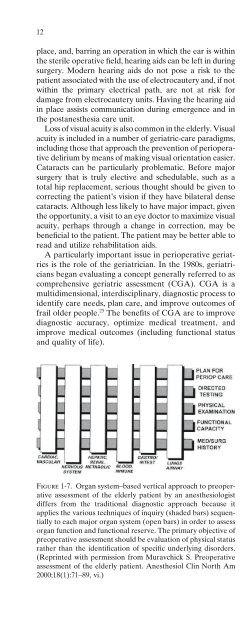Geriatric Anesthesiology - The Global Regional Anesthesia Website
Geriatric Anesthesiology - The Global Regional Anesthesia Website
Geriatric Anesthesiology - The Global Regional Anesthesia Website
Create successful ePaper yourself
Turn your PDF publications into a flip-book with our unique Google optimized e-Paper software.
12 J.H. Silverstein<br />
place, and, barring an operation in which the ear is within<br />
the sterile operative field, hearing aids can be left in during<br />
surgery. Modern hearing aids do not pose a risk to the<br />
patient associated with the use of electrocautery and, if not<br />
within the primary electrical path, are not at risk for<br />
damage from electrocautery units. Having the hearing aid<br />
in place assists communication during emergence and in<br />
the postanesthesia care unit.<br />
Loss of visual acuity is also common in the elderly. Visual<br />
acuity is included in a number of geriatric-care paradigms,<br />
including those that approach the prevention of perioperative<br />
delirium by means of making visual orientation easier.<br />
Cataracts can be particularly problematic. Before major<br />
surgery that is truly elective and schedulable, such as a<br />
total hip replacement, serious thought should be given to<br />
correcting the patient’s vision if they have bilateral dense<br />
cataracts. Although less likely to have major impact, given<br />
the opportunity, a visit to an eye doctor to maximize visual<br />
acuity, perhaps through a change in correction, may be<br />
beneficial to the patient. <strong>The</strong> patient may be better able to<br />
read and utilize rehabilitation aids.<br />
A particularly important issue in perioperative geriatrics<br />
is the role of the geriatrician. In the 1980s, geriatricians<br />
began evaluating a concept generally referred to as<br />
comprehensive geriatric assessment (CGA). CGA is a<br />
multidimensional, interdisciplinary, diagnostic process to<br />
identify care needs, plan care, and improve outcomes of<br />
frail older people. 25 <strong>The</strong> benefits of CGA are to improve<br />
diagnostic accuracy, optimize medical treatment, and<br />
improve medical outcomes (including functional status<br />
and quality of life).<br />
Figure 1-7. Organ system–based vertical approach to preoperative<br />
assessment of the elderly patient by an anesthesiologist<br />
differs from the traditional diagnostic approach because it<br />
applies the various techniques of inquiry (shaded bars) sequentially<br />
to each major organ system (open bars) in order to assess<br />
organ function and functional reserve. <strong>The</strong> primary objective of<br />
preoperative assessment should be evaluation of physical status<br />
rather than the identification of specific underlying disorders.<br />
(Reprinted with permission from Muravchick S. Preoperative<br />
assessment of the elderly patient. Anesthesiol Clin North Am<br />
2000;18(1):71–89, vi.)<br />
Table 1-4. Focus areas for assessment of geriatric patients.<br />
Medical<br />
Organ function and reserve<br />
Medical illnesses<br />
Medications<br />
Nutrition<br />
Dentition<br />
Hearing<br />
Vision<br />
Pain<br />
Urinary incontinence<br />
Mental<br />
Cognitive status<br />
Emotional status<br />
Spiritual status<br />
Physical<br />
Functional status<br />
Balance and gait<br />
Falls<br />
Environmental<br />
Social, financial status<br />
Environmental hazards<br />
In the perioperative arena, cooperative programs that<br />
feature some version of CGA have been evaluated. <strong>The</strong><br />
most common perioperative environment for these programs<br />
has been hip fracture services. In a review of orthogeriatric<br />
care, Heyburn and colleagues 26 described four<br />
models that have been applied to hip fracture patients:<br />
the traditional model in which care is directed by the<br />
orthopedic surgeon and medical queries are directed to a<br />
consultant; the second is a variation in which multidisciplinary<br />
rounds with geriatricians and surgeons increase<br />
awareness of cross-specialty issues; the third involves<br />
early postoperative transfer to a geriatric rehabilitation<br />
unit; and the fourth is combined orthogeriatric care in<br />
which the patient is admitted to a specialized ward where<br />
care is coordinated by geriatricians and orthopedic surgeons.<br />
Delirium is a common complication following hip<br />
fracture and has been the primary outcome of interest<br />
for some of these studies. (See also Chapters 9 and 24.)<br />
Edward Marcantonio conducted a randomized trial of<br />
proactive geriatric consultation based on a structured protocol<br />
for patients with hip fractures (Table 1-5). <strong>The</strong> intervention<br />
reduced delirium by more than one-third.<br />
In his review for the Freeman lecture, Rubenstein succinctly<br />
summed up the general state of affairs when he<br />
remarked that, despite the relatively consistent body of<br />
evidence supporting the utility of CGA and other geriatric<br />
follow-up programs, they have failed to be instituted<br />
on a wide scale. Soon after the initial successful reports,<br />
the institution of prospective payment diagnostic related<br />
groups (DRG) as part of the Medicare program made<br />
any additional stay in the hospital unprofitable. In fact,<br />
although CGA is effective at preventing rehospitaliza-
















